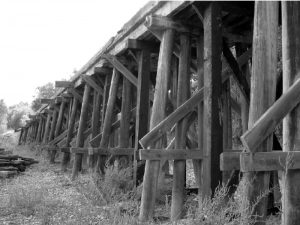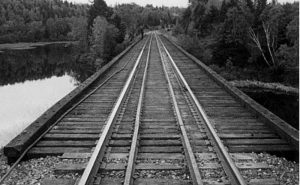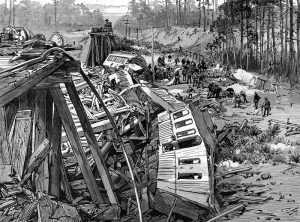Blackshear, Georgia, is located about 90 miles southwest of Savannah. The Savannah, Florida, and Western Railroad (formerly the Atlantic Gulf Railroad) ran southwesterly from Savannah to Bainbridge and opened in December 1867 after starting construction as early 1859. About one mile northeast of Blackshear, the line crossed the Alabaha (sometimes called the Hurricane) River on an iron bridge that was flanked by long wooden trestles as was common at the time to keep costs low. The trestle that failed was reported to be 300 feet long and 25 feet above the ground. The trestle had been updated two years prior to the disaster with the Engineering News reporting,

“The trestle on the Savannah, Florida & Western Ry., on which the dreadful accident occurred, noted last week, is stated by C. S. Wyckoff, formerly an engineer in the service of the company, to have been rebuilt within two years and to have been in thoroughly good condition. The trestle is stated to be of the ‘inverted W type, which is the strongest known to engineering,’ although it is certainly not the most approved; and the piling, according to Mr. Wyckoff, must have been remarkably well done, and it is stated by him that each pile in the trestle bridges ‘is driven with a hammer weighing 2,200 pounds falling 10 feet until the last blow only moves it 1⁄8 inch.’ We have heard of such pile driving in textbooks, but we have never yet seen it on any railway in America, and we are glad to know that it exists somewhere.”
Trestles at the time consisted of two or more piles with framing up to a cap beam. Then, on top of the cap beams, wooden stringers, generally two in number, and the wooden ties laid on the stringers.

Many other railroads around the country continued to use wooden trestles as approaches to their iron bridges across major rivers of the United States. Even though they only had a life of 8-10 years, they were considered an economical choice by many engineers and railroad companies. Some railroads put speed restrictions on their wooden trestles.
All was well on the line until 9:30 am on March 17, 1888, when the Atlantic Coast Fast Mail train out of Savannah approached the bridge. One newspaper account wrote,
“The baggage car got off the track about a quarter of a mile before it reached the bridge at Hurricane river. The baggage car mounted the track, but the train passed safely over the bridge [main river bridge]. Immediately on the other side of the bridge, there is a trestle several hundred feet in length. When the baggage car struck the trestle work, it gave way, and the entire train, with the exception of the engine, dropped through and, with the exception of one car, was completely wrecked. The train consisted of a combination car, three baggage cars, a smoking car, one coach, two Pullman sleepers, and the private car of the Lehigh valley…”
Another wrote,
“In the creek [it was dry at the site], all was chaos and confusion. The cars were piled on the top of each other, and the cries of the frightened, injured passengers arose from a caldron of death. Nineteen dead bodies were taken from the wreck as soon as help could be organized. There may be others yet to be found.”
Engineering News wrote,
“The front truck of the baggage car became derailed ‘fully a quarter of a mile’ before the bridge over the Hurricane [Alabaha] river was reached, with the train on a downgrade and running at high speed. The apparent cause was a broken axle. Before the train struck the bridge, several other cars were derailed, and the trucks wobbled back and forth over the roadbed considerably, never getting very far out, as is not only distinctly stated but conclusively shown by the fact that the bridge proper was passed in safety by the entire train. The bridge was of considerable length; one account says 500 feet, but ‘the marks of broken axles (more likely, wheels, or the most part) show for several hundred yards on the roadbed and bridge.’ Beyond the bridge, however, was 500 to 800 feet of trestle approach. As soon as the derailed train struck this, it began to go over, but not so rapidly, but that it fell only after passing the first third of the trestle, knocking its apology for a floor all to pieces and demolishing the stretch beyond completely. The engine escaped, but the tender was dragged down with the rest of the train. It appears clear from these facts that the floor was merely the common one of 8- or 9-foot ties spaced 2 feet or so apart and with no pretense of guardrail. If wrong as to this particular floor, we shall be pleased to do justice to it as conspicuously as possible when details reach us, but there are thousands of trestles in the South with just exactly that kind of floor, and plenty of them in the North as well. It is such a paltry economy as compared with 12- or 14-foot ties spaced close together and with heavy outside guardrails, that for the most part, its use comes merely from thoughtlessness and inexperience in operating. We have some drawings in preparation showing how a trestle should be built, which will help to reinforce this moral, and until then, we pass it. Even with such a trestle floor, however, the circumstances make it highly probable that good re-railing bridge guards would have put enough of the trucks back on the rails at the entrance of the bridge to have ensured the safety of the train on the trestle, even if a broken axle was, in fact, the original cause of the derailment, which is not entirely clear. There has been enough money loss from this accident alone, not to speak of the loss of life, to equip the whole State of Georgia with re-railing guards at every bridge and trestle. We hope and believe that in time these repeated lessons will be heeded.”
The magazine had been advocating for stronger decks, outside guardrails, and re-railing guards on the approaches for years at the time. The speed of the train was estimated at 45 miles per hour, and the Railroad Gazette wrote,
“The tender was derailed 1,200 feet before reaching the bridge, which consists of a bridge proper over Hurricane River and wooden trestle approaches at either end. The derailment seems not to have been promptly discovered, and the whole train passed over the bridge and trestle until the tender got within 90 feet of the further abutment, where the derailed truck slewed around and tore up the sleepers. The tender broke loose from the engine and, on reaching the abutment, fell about 20 feet, the rest of the train following it. The only information we have concerning the speed of the train is the testimony of the porter of the sleeping car, who said it was 45 miles an hour. The officers of the road have found no evidence of a broken wheel or axle, and the track, which is of 60-pound steel, shows no evidence of any defect. The testimony of the passengers goes to show that the cars, even the strongest of them, were completely crushed in, some of them failing upon others…

We do not know the real condition of this Hurricane River trestle. There may have been a guard timber, and the sleepers may have been securely blocked to prevent bunching, but the description of the action of the tender truck indicates that the trestle was faulty in both these respects. The train may have been running at a reasonable speed, but the indications are that it was running at a 40-mile rate on a bridge which was suited for half that speed…The question of speed modifies all questions of this kind and really should be a first consideration, though it is often made the last in importance. There are miles of weak trestles which the owners cannot afford to rebuild; there are numerous roads which cannot at once renew even the floors of these bridges, but they can run slowly over these shaky structures. The question is whether people will continue to entrust their lives to such roads when they bid for patronage by running fast trains in spite of the great risks that must be taken.”
Newspapers around the country picked up on the disaster that killed 19 and injured 35. Many more would have died, but it was written, “The train caught fire from the stoves, but the heroic presence of mind of Engineer Welsh, who leaped from his engine and put out the fire, prevented an awful cremation.”
The failure was, therefore, due to a derailment and, in the eyes of the Engineering News, a poorly designed trestle with ties too short, too widely spaced, and with no curb to keep trains on the structure.■
